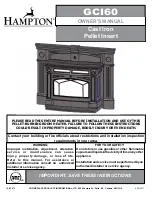
MANUAL
MANUAL
MANUAL
MANUAL
ILARIA
ILARIA
ILARIA
ILARIA
The cylindrical pellets have a diameter of 5 - 7 mm, a length that varies between 10 and 50 mm,
and a weight of around 650 kg/m
3
. The low moisture content (8 - 10%) means they have a higher
calorific value.
The DIN 51731 standards define the quality of the pellets:
Length :
approx. 10 - 30 mm
Diameter:
approx. 6 - 10 mm.
Density:
approx. 650 kg/m
3
Calorific value:
approx. 4.9 kWh/kg
Residual moisture:
approx. 6 - 12 %
Ash:
<1.5%
Specific weight:
>1.0 kg/dm
3
The pellets must be transported and stored completely dry. Upon contact with moisture they swell
up and can no longer be used. Consequently, they need to be protected against humidity and
moisture both during transport and storage.
4. Safety devices
The ILARIA pellet stove features sophisticated safety systems that, if one of the parts breaks or
there are faults in the flue, prevent damage to the stove and the home.
In any case, when a problem occurs, the pellet feed system is immediately stopped.
THE PELLETS
-7-
The cylindrical pellets have a diameter of 5 - 7 mm, a length that varies between 10 and 50 mm,
and a weight of around 650 kg/m
3
. The low moisture content (8 - 10%) means they have a higher
calorific value.
The DIN 51731 standards define the quality of the pellets:
Length :
approx. 10 - 30 mm
Diameter:
approx. 6 - 10 mm.
Density:
approx. 650 kg/m
3
Calorific value:
approx. 4.9 kWh/kg
Residual moisture:
approx. 6 - 12 %
Ash:
<1.5%
Specific weight:
>1.0 kg/dm
3
The pellets must be transported and stored completely dry. Upon contact with moisture they swell
up and can no longer be used. Consequently, they need to be protected against humidity and
moisture both during transport and storage.
4. Safety devices
The ILARIA pellet stove features sophisticated safety systems that, if one of the parts breaks or
there are faults in the flue, prevent damage to the stove and the home.
In any case, when a problem occurs, the pellet feed system is immediately stopped.
THE PELLETS
-7-
-24-
-24-
To remove the flame trap, pull it out of the
supports.
Vacuum up all the ash that has deposited on the
flame trap and reposition it correctly, with the bent
side facing upwards, as shown in the figure.
After a few hours of operation, it is normal for
the flame trap to show deposits on surface.
To clean the glass, use a damp rag with at most
a few sprays of window cleaner.
When cleaning the glass, always check
that the grey gasket around the glass is in
good condition; a worn gasket will affect the
operation of the stove.
To remove the flame trap, pull it out of the
supports.
Vacuum up all the ash that has deposited on the
flame trap and reposition it correctly, with the bent
side facing upwards, as shown in the figure.
After a few hours of operation, it is normal for
the flame trap to show deposits on surface.
To clean the glass, use a damp rag with at most
a few sprays of window cleaner.
When cleaning the glass, always check
that the grey gasket around the glass is in
good condition; a worn gasket will affect the
operation of the stove.


































